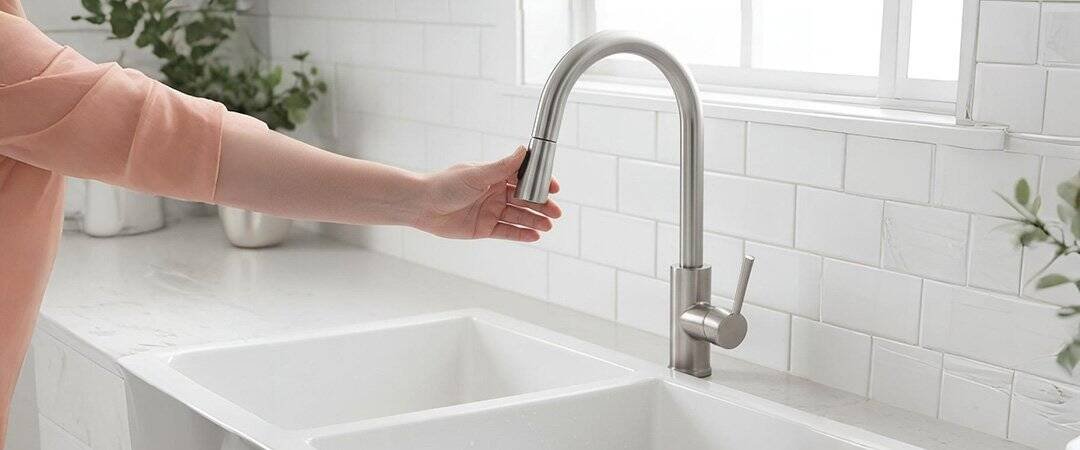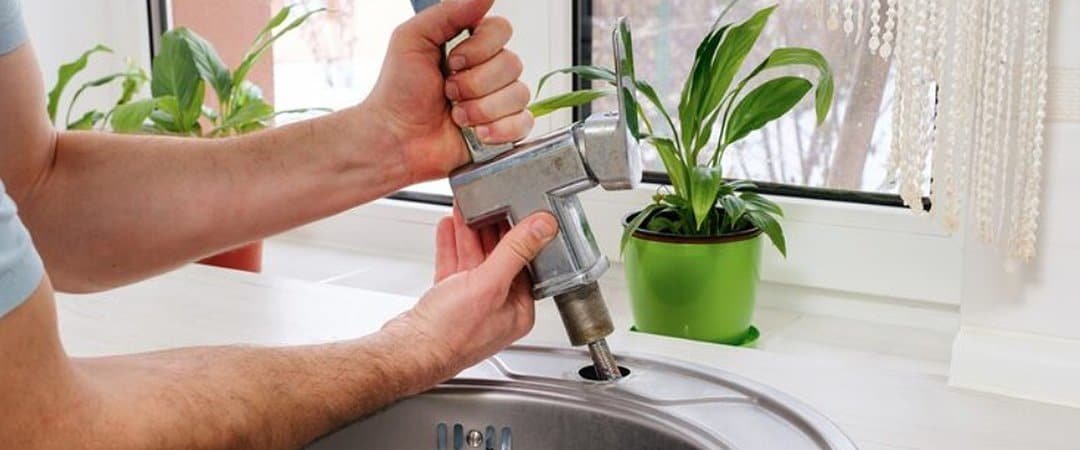The kitchen faucet is central to your daily routine, but when the kitchen faucet swivel becomes stiff, wobbly, or leaky, it can disrupt everything.
The good news: fixing it doesn’t require an expensive professional. With a few DIY steps, you can repair the swivel mechanism and restore full function. This guide covers how to diagnose and solve the three most common issues—stiffness, looseness, and leaks.
Table of Content
- Essential Preparation and Anatomy (Before You Touch a Tool)
- Diagnosis and Procedural Priority
- Repair Manual I: Curing a Stiff or Seized Faucet Spout
- Repair Manual II: Securing a Loose and Wobbly Faucet Base
- Repair Manual III: Eliminating Leaks from the Swivel Base
- Navigating Brand-Specific Designs and Advanced Faucet Types
- Proactive Maintenance and Knowing When to Call a Professional
- Conclusion: Your Faucet, Fixed and Functional
- FAQs
Essential Preparation and Anatomy (Before You Touch a Tool)
Before you dive under the sink, let’s get acquainted with the parts and ensure we’re prepared for a smooth repair.
Understanding the Faucet’s Core Components
Knowing the names of the parts helps tremendously when figuring out what’s broken.
- Faucet Body: This is the stationary base of the faucet that is mounted to your counter.
- Spout: The movable neck that delivers water.
- Mounting Hardware: Located beneath the sink, these nuts and washers clamp the entire faucet securely to the countertop.
- Retaining Mechanism: This is what fastens the spout to the body. It might be a small, hidden set screw or a threaded collar (or bonnet).
- O-Rings and Seals: These small rubber or plastic gaskets are the unsung heroes! They perform a dual purpose: creating a watertight seal and providing the lubricated, low-friction surface that allows the spout to glide smoothly.

The Tool Checklist (Must-Haves)
A successful repair depends on having the right tools ready.
| Category | Item |
|---|---|
| Essential for All Repairs | Adjustable wrench, screwdrivers, flashlight, cleaning rags. |
| For Stiff/Leaking Faucets | Allen key set, needle-nose pliers, replacement O-rings, silicone-based plumber’s grease, white vinegar or CLR cleaner. |
| For Loose Faucets | Basin wrench (highly recommended), penetrating oil (for rusted nuts). |
Expert Tip: Use a basin wrench to tighten a loose base. Its long shaft and pivoting jaw are designed for the tight, awkward space under the sink where other wrenches can’t work effectively.
Critical Safety First: Shutting Off Water and Relieving Pressure
This is a non-negotiable step to prevent unexpected water damage.
- Locate Shut-Off Valves: Look in the cabinet directly beneath the sink for two small valves (hot and cold). Turn both handles clockwise until they are firmly closed. If you don’t have individual valves, you must turn off the main water supply for the house.
- Relieve Pressure: Once the water supply is off, open the kitchen faucet handle to the “on” position. This will drain the remaining water in the lines and release all residual pressure, preventing an unexpected spray when you disassemble the faucet.
Diagnosis and Procedural Priority
Before we start turning screws, let’s figure out the root cause. This often prevents unnecessary work!
The Diagnostic Flowchart
Most swivel faucet issues are interconnected, often starting with mineral buildup from hard water. Scale makes O-rings bind and causes stiffness, and forcing the swivel often loosens the mounting nut, leaving the faucet wobbly.
| Symptom | Primary Cause(s) |
|---|---|
| Spout is Stiff/Seized | Mineral buildup (limescale) or dry/worn O-rings. |
| Entire Faucet Wobbles/Spins | Loose mounting nut(s) under the sink. |
| Water Drips/Pools at Spout Base | Failed or deteriorated O-rings and seals. |
Expert Tip: Stiffness is the Root Cause If your faucet is both stiff and loose, the stiffness is the likely initial problem. You need to address the stiffness first (cleaning and lubrication) before securing the base.
Repair Manual I: Curing a Stiff or Seized Faucet Spout
A stiff spout means friction, which we eliminate through cleaning and proper lubrication.
Disassembling the Spout
You need to access the swivel joint, which is held together by the retaining mechanism.
- Find the Retaining Mechanism:
- Set Screw: Look for a small screw on the back or side of the faucet base, sometimes hidden by a decorative plastic plug. Pry the plug out and use the appropriate size Allen key (hex wrench) to loosen the screw.
- Threaded Collar: If there’s a collar or bonnet at the base, it must be unscrewed counter-clockwise. Crucial Tip: Wrap the collar with a soft cloth before gripping it with pliers to avoid scratching the finish.
- Remove the Spout: Once the retainer is loose, pull the spout straight up, applying a gentle twisting motion.

Deep Cleaning Mineral Buildup (Limescale)
Those white, crusty deposits are limescale, and they must be removed.
- Vinegar Soak: White vinegar is a safe and effective solvent. Wrap vinegar-soaked paper towels around the faucet post and let the parts soak for a few hours—or overnight if the buildup is severe.
- Tackle the Stubborn Stuff: For very stubborn deposits, commercial cleaners like CLR can be used (just be sure to follow safety instructions!).
- Final Scrub: After soaking, use a small, non-abrasive brush (like an old toothbrush) to scrub away all the loosened scale . Rinse everything thoroughly.
Servicing the O-Rings and Seals
Remember, the O-rings fail at their low-friction function first, causing stiffness before they even leak.
- Remove and Clean: Use a dental pick or small screwdriver to carefully pry the old O-rings out of their grooves. Thoroughly clean the grooves beneath them.
- Lubricate and Install»: Apply a generous coat of silicone-based plumber’s grease to the new O-rings and inside the clean grooves. Crucial Warning: You must use silicone-based grease, as petroleum-based products like Vaseline can cause the rubber seals to degrade over time.
- Reassemble: Roll the new, greased O-rings into place, making sure they are seated properly and not twisted . Slide the cleaned and lubricated spout back on—it should rotate smoothly now.
Repair Manual II: Securing a Loose and Wobbly Faucet Base
If your faucet wobbles, the mounting hardware underneath the sink is loose. This is where the basin wrench truly shines!
- Access the Hardware: Clear out the cabinet under the sink. Use your flashlight to locate the mounting nut(s) threaded onto the faucet’s shank.
- Stabilize and Tighten:
- Have a helper hold the faucet from above, ensuring it is perfectly straight on the countertop.
- If the nut is metal, position the jaws of your basin wrench around the nut.
- Turn the basin wrench handle clockwise to tighten the nut until it is snug. Warning: Be careful not to overtighten, as this can damage the mounting hardware or crack a porcelain sink.
- Troubleshooting: If the nut is rusted and won’t turn, spray it with a penetrating oil and let it soak for at least 15 minutes before trying the wrench again. If the mounting hardware is stripped or cracked, the entire faucet assembly will need to be replaced.
Repair Manual III: Eliminating Leaks from the Swivel Base
Water pooling at the base means the O-rings have hardened, cracked, and lost their seal from constant movement and water exposure. The fix is simple—replace them.
- Disassemble: Follow the steps above to get the spout off the faucet body.
- Remove Old Rings: Use a pick to carefully remove all the old O-rings from the grooves. Note how many there were and their position.
- Source the New Rings: This is key! Take the old O-rings to a hardware store to find exact-size replacements . Universal O-ring kits may not contain the precise size you need.
- Install: Thoroughly clean the grooves. Apply a thin, even layer of silicone-based plumber’s grease to each new O-ring before rolling them into place. Ensure they are not twisted.
- Reassemble and Test: Put the spout back on and secure the retaining mechanism. Slowly turn the water supply back on and check the joint for leaks.

Navigating Brand-Specific Designs and Advanced Faucet Types
While the basic principles are always the same, accessing the O-rings can differ depending on who manufactured your faucet.
Specific Disassembly Notes
- Moen Faucets (Cartridge System): You’ll typically need to remove the handle (often with a hex screw), lift off a dome, and unscrew plastic sleeves to reach the cartridge and O-rings.
- Delta & Peerless Faucets (Ball Valve System): Older models require removing the handle and unscrewing the large chrome cap to access the cam and the slotted ball valve.
- Pfister Faucets: These models can vary widely. It’s best to consult the manufacturer’s specific instructions for your exact model.
- Pull-Down/Pull-Out Faucets: If the swivel is stiff, first check the retractable hose underneath—sometimes it’s just bunching up or catching on something. If the mechanism itself is the issue, proceed with the standard cleaning/lubrication repair.
Proactive Maintenance and Knowing When to Call a Professional
Your faucet is fixed—fantastic! Now let’s keep it that way.
Preventative Maintenance for a Long-Lasting Faucet
- Annual Lubrication: If you live in a hard water area, make it a habit to disassemble the spout once a year to clean the joint and re-apply silicone grease to the O-rings. This simple step prevents stiffness from starting.
- Consider a Water Softener: If limescale is a persistent problem everywhere in your home, installing a whole-house water softener is the most effective long-term solution to protect your plumbing fixtures.

When to Put Down the Wrench
Some issues need a pro. Don’t risk costly damage trying to fix these yourself.
- Persistent Leaks: If a leak continues after you’ve correctly replaced and greased the O-rings, there might be a defect or crack in the faucet body itself.
- Corroded or Stuck Shut-Off Valves: If the valves under your sink are seized, do not force them. Breaking a seized valve can cause a major flood that requires immediate professional attention.
- Signs of Structural Damage: If you see water stains on the cabinet floor or on the ceiling below the kitchen, this indicates a long-term leak that may have caused mold or structural rot, requiring professional assessment.
If you’d like to directly replace your kitchen faucet, please check the post below for more details.
Conclusion: Your Faucet, Fixed and Functional
You tackled the wobbly base, eliminated the leak, or cured the stiffness! By methodically diagnosing the issue and following these procedures, you not only saved the cost of a professional service call but also gained a deeper understanding of your home’s mechanics. Enjoy that smooth kitchen faucet swivel!

